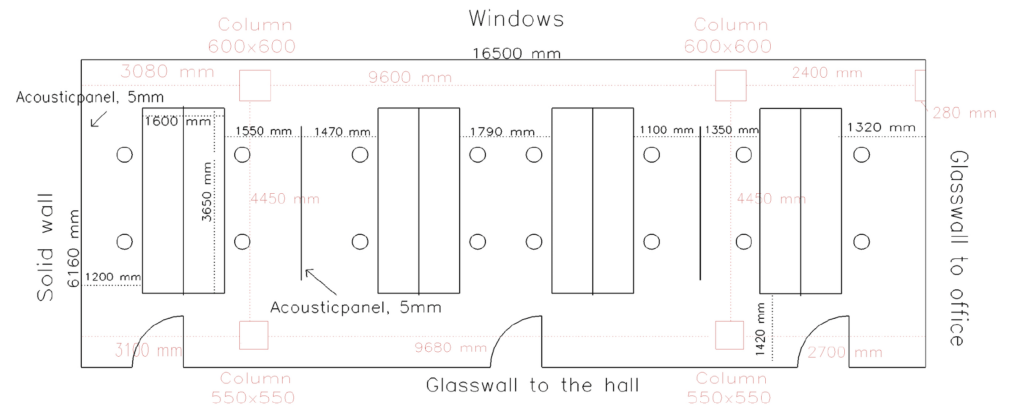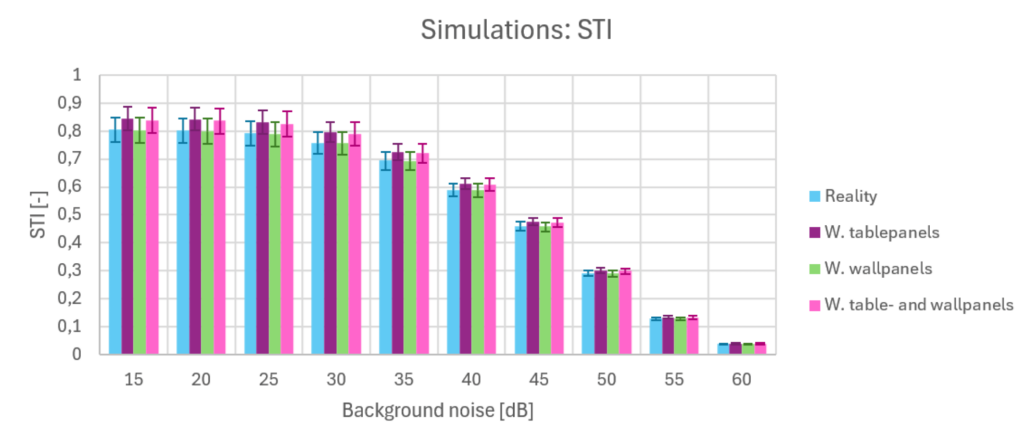
Increase in open-plan solutions
Open-plan offices have gradually become a preferred model for companies to use, mainly to encourage spontaneous interactions between coworkers, but also because of the aesthetics around a big open room. Further, there is an economic benefit of having as many workstations as possible in fewer square meters. However, these benefits often come at the cost of acoustic challenges.
The study conducted by us, Freja Thybo and Stine Werngreen, from the Technical University of Denmark highlights the complexity of managing acoustics in open-plan offices. Particularly concerning the Speech Transmission Index (STI). The study aimed to identify and propose solutions for the acoustic issues in an open-plan office at Rigshospitalet’s Center for Hearing and Balance. The floor plan of the investigated office is illustrated in the figure below.

Results
Through the survey, two problem areas were identified by the employees: conversation between colleagues and phone conversations with patients. Both problems are perceived as distracting, affecting both the concentration and comfort of the employees.
Analyzing the results of the measurements, it is found that the STI at the office is very high which corresponds to the answers from the survey. Seen in the figure below, the STI reaches a minimum of 0.68 at 14 m from the sound source. This is far above the acceptable value of 0.45. While the STI is very high, the background noise is very low compared to the recommended value of 35-45 dB. Also, the A-weighted SPL at 4 m seems to be too high, indicating a need for more sound absorption.
Though the measurements strongly indicate problems with STI and background noise, the reverberation time and spatial decay in the office are considered OK since they just uphold the requirements set in ISO 22955.

Simulations
After identifying the STI as the main acoustic problem in the open-plan office, 4 models are created to simulate and test the effect on the STI. The simulations test 3 different scenarios containing table panels, wall panels, and a combined solution, which are all evaluated against model 1 representing the existing reality of the office.

However, the results of the simulations showed no decrease in the STI at any of the implementations. The figure above shows an increase in the STI when implementing table panels and both types of panels, while the wall panels alone do not change anything. The figure also shows the relation between the background noise and STI, indicating that a higher background noise would contribute to lower STI. However, to get the STI below the acceptable value of 0.45 the background noise needs to exceed the recommended max value of 45 dB and reach around 50 dB.
Alternative acoustic solutions
This paradoxical outcome underscores the complexity of acoustic management in open-plan environments. Traditional treatments like table panels and wall panels, which primarily target reverberation time and SPL, are insufficient for addressing STI-related issues. Therefore, alternative solutions need to be considered.
Sound masking systems:
These systems create background noise designed to reduce the intelligibility of human speech, thereby enhancing privacy and focusing. In addition, sound masking can contribute to a consistent level of ambient sound, preventing fluctuations that can be particularly distracting. The downside of this solution is that some employees may find it difficult to adapt to the background noise, particularly if it is not finely tuned to a comfortable and effective level. The worst case is naturally that the added noise itself can become a source of annoyance and discomfort.
Noise-cancelling headphones:
A more modern and simple approach to acoustic challenges in open-plan offices is the use of noise-cancelling headphones. This solution reduces noise at the individual level, rather than attempting to manage the overall sound environment. Depending on the quality, the noise-cancelling headphones can reduce the background noise a lot if not completely when used. This can increase productivity and reduce the cognitive load associated with constant noise. However, good quality noise-cancelling headphones come at a matching price. So, if it is a large open-plan office this can be a high-cost solution.
Behavioral guidelines in open-plan offices:
A non-physical solution is implementing behavioral guidelines. Examples of collective guidelines from ISO 22955 that would be effective in the open-plan office at Rigshospitalet:
- Speak quietly on the phone and with colleagues.
- Avoid discussions with distant workstations, favor instant messaging or meeting rooms.
- Avoid individual briefings or training at a workstation.
Guidelines are a low- to no cost solution compared to purchasing and installing physical implementations. Moreover, guidelines are adaptable and can be revised based on ongoing effectiveness or changes in office dynamics. Further, it encourages responsible and considerate behavior. There will still be a risk that the employees may become complacent, forget, or choose not to follow the guidelines over time, reducing their effectiveness. Another aspect is the fact that guidelines do not provide a physical reduction in noise across an open space.
Conclusion
The study at Rigshospitalet’s Center for Hearing and Balance highlights the challenges of managing acoustics in open-plan offices. While traditional treatments can mitigate some aspects of acoustic issues, they fall short in addressing STI. To achieve a truly optimal acoustic environment, a comprehensive approach that includes sound masking systems, noise-cancelling headphones, or guidelines is essential. These treatments will help create a more productive and comfortable workspace for employees, where the benefits of open-plan design are balanced with the need for effective acoustic management.
Freja Thybo Bachelor student at DTU – Technical University of Denmark
Stine Werngreen Bachelor student at DTU – Technical University of Denmark

